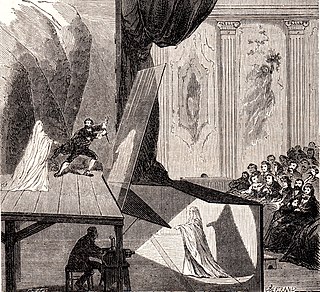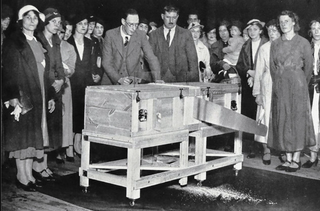
The Balducci levitation is a levitation illusion first described by Ed Balducci. Its inventor is unknown. It is an impromptu magic trick, which has been popularized by many magicians, such as David Roth, Paul Harris, and David Blaine.

David Seth Kotkin, known professionally as David Copperfield, is an American magician, described by Forbes as the most commercially successful magician in history.

Pepper's ghost is an illusion technique, used in the theatre, cinema, amusement parks, museums, television, and concerts, in which an image of an object off-stage is projected so that it appears to be in front of the audience.

Sawing a woman in half is a generic name for a number of stage magic tricks in which a person is apparently cut or divided into two or more pieces.
The Asrah levitation, sometimes called Lighter than Air, is a classic levitation illusion.

Jim Steinmeyer is an American author, inventor, and designer of magical illusions and theatrical special effects. He holds four US patents in the field of illusion apparatus, including a modern version of the Pepper's Ghost illusion. Steinmeyer has consulted for many famous magicians, including David Copperfield, Doug Henning, Siegfried and Roy, and Lance Burton.

David Copperfield's laser illusion is an illusion performed by David Copperfield in several magic shows. The magician or his assistant is cut by a "laser" into two or more parts and starts walking.

The Chinese Water Torture Cell is a predicament escape made famous by Hungarian-American magician Harry Houdini. The illusion consists of three parts: first, the magician's feet are locked in stocks; next, he is suspended in mid-air from his ankles with a restraint brace; finally, he is lowered into a glass tank overflowing with water and the restraint is locked to the top of the cell.

John Gaughan is an American manufacturer of magic acts and equipment for magicians based in Los Angeles, California. His style of work is classic, not based heavily on machinery and technology.
Origami is a magic stage illusion with a Japanese paperfolding theme, designed by Jim Steinmeyer. It was originally performed in 1986 by Canadian illusionist Doug Henning, using a working prop constructed by illusion builder John Gaughan. Illusionist David Copperfield later introduced presentational changes that would be widely copied by other performers.
The table of death is a predicament escape that may be regarded as a magic trick or an act of escapology.
André Kole was an American magician and inventor of magical effects. He was also a committed Christian and a public speaker for the evangelical group Campus Crusade for Christ. He was also known for using his magical knowledge to debunk frauds and hoaxes.
A magician's assistant is a performer in a magic act who is not billed as the magician or principal name in the act.

Adelaide Herrmann (1853–1932) was an English magician and vaudeville performer billed as "the Queen of Magic." She was married to Alexander Herrmann, another magician.
Stage illusions are large-scale magic tricks. As the name implies, stage illusions are distinct from all other types of magic in that they are performed a considerable distance away from the audience, usually on a stage, in order to maintain the illusion. Stage illusions usually use large props and may involve the use of assistants or large animals. Examples of stage illusions include sawing a woman in half and Lady-to-Tiger.
Joanie Spina was an American dancer, choreographer, magician and director who achieved prominence through her work with the illusionist David Copperfield.
Clearly Impossible is a variation of the illusion of sawing a woman in half devised by Jonathan Pendragon.

Magic, which encompasses the subgenres of illusion, stage magic, and close-up magic, among others, is a performing art in which audiences are entertained by tricks, effects, or illusions of seemingly impossible feats, using natural means. It is to be distinguished from paranormal magic which are effects claimed to be created through supernatural means. It is one of the oldest performing arts in the world.

A levitation illusion is one in which a magician appears to defy gravity by making an object or person float in the air. The subject may appear to levitate unassisted, or it may be performed with the aid of another object in which case it is termed a "suspension".











